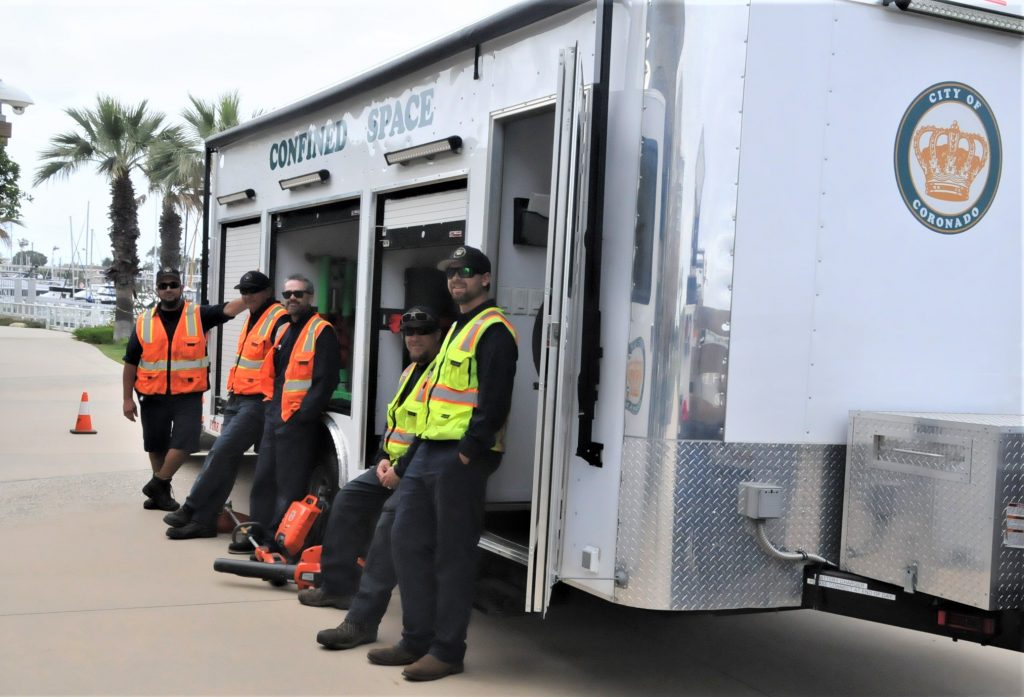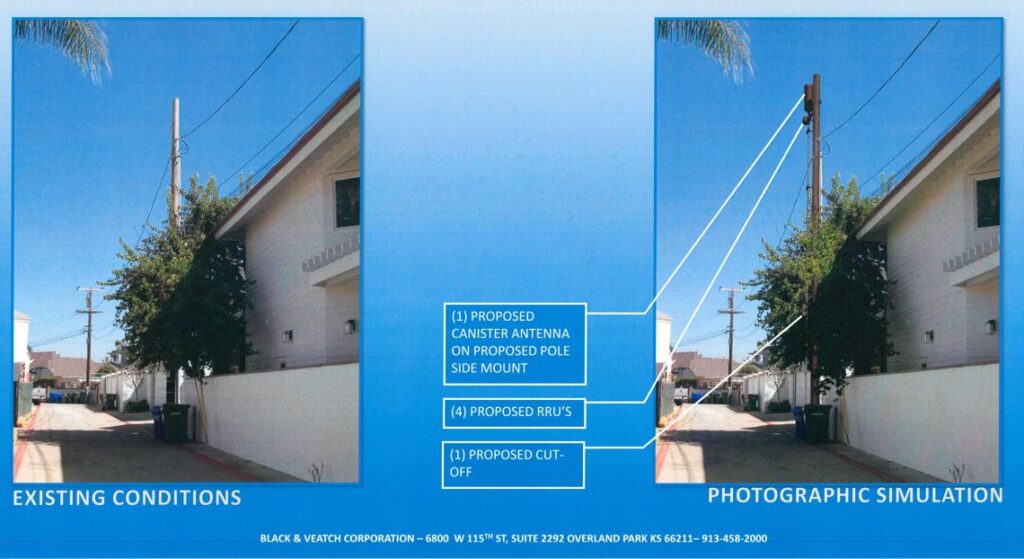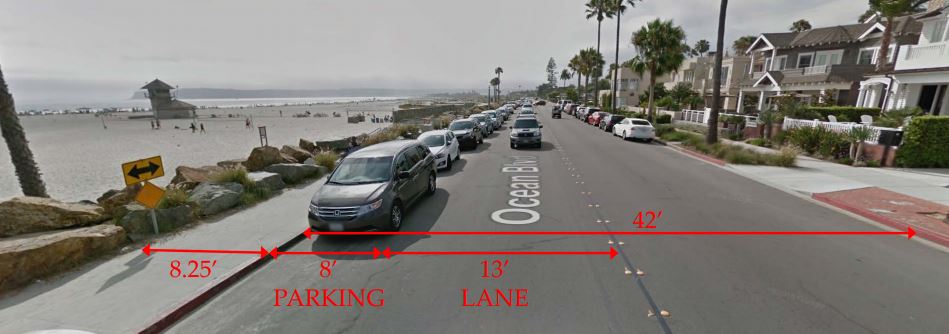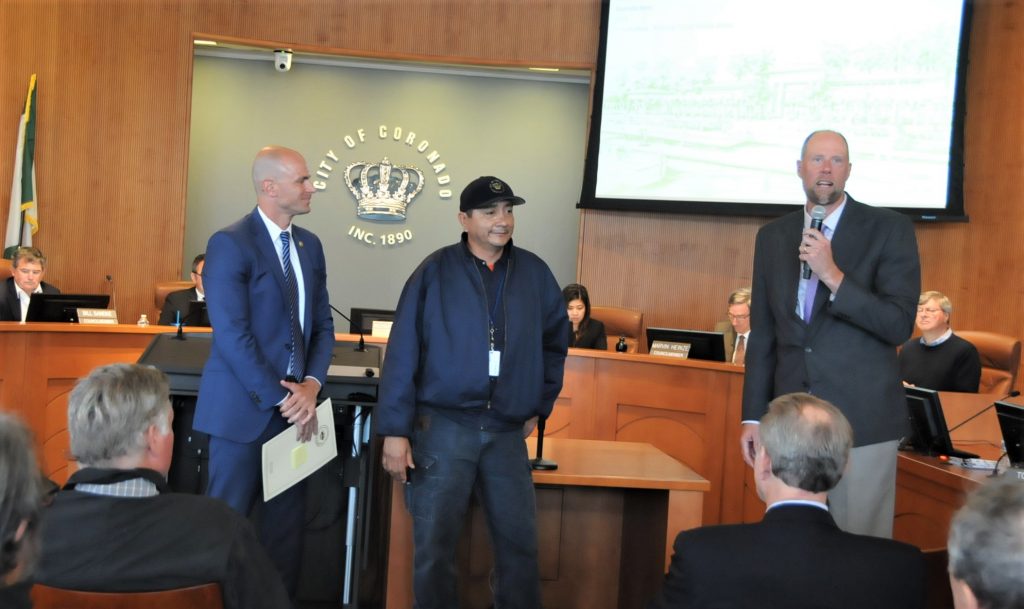Mayor Bailey presented Wastewater Pump Mechanic Robert Rodriguez and Cliff Maurer, Director of Public Services and Engineering, with a proclamation for the 59th annual National Public Works Week May 19 through May 25. He cited the tremendous work that the Public Works personnel perform on infrastructure, facilities and services that are of vital importance to our community, enhancing public health and quality of life.

Wireless Communications Facilities
Frustration was the prevailing theme regarding the requested installation of Wireless Communications Facilities (WCF), the most discussed agenda item of the evening. The proposed sites are: 1145 F Avenue, 956 Orange Avenue, 411 D Avenue, and 541 Ocean Blvd. The proposed facilities will have 4G technology, not 5G, but will most likely be upgraded in the future. Three of the four sites require telephone pole replacement, with the largest at 43 feet tall on Ocean Blvd.

Sixteen residents spoke and five wrote letters against the installation of these four and potential future WCFs citing health hazards and aesthetics as the two main issues of concern. After the public comments, Mayor Bailey summarized the questions which addressed the fact that the city receives no compensation for this, and that the locations are requested by AT&T (and other wireless carriers). He pointed out that the city is not allowed to take the health effects into consideration when making their decision, per the Federal Government ruling,
Federal law largely preempts City Council authority when it comes to wireless communications facilities in the public right-of-way. The Telecommunication Act of 1996 expressly prohibits state or local regulations that have the effect of prohibiting the
ability of any entity to provide any interstate or intrastate telecommunications service. This has been interpreted very broadly to extremely limit local authority. The City Council is also expressly prohibited from regulation of wireless communication facilities based on radio frequency emissions. Regulations by local agencies with regard to aesthetics must be reasonable, no more burdensome than those applied to other infrastructure deployments, objective, and published in advance.
The matter before the City Council is an administrative decision, sometimes called “quasijudicial,” involving the application of existing laws or policies to a given set of facts. Courts generally give less deference to decision makers in administrative mandate actions and will inquire:
(a) whether the city proceeded without, or in excess of its jurisdiction; (b) whether there was a fair hearing; or (c) whether there was any prejudicial abuse of discretion (which is established when (i) the city has not proceeded in the manner required by law, (ii) the decision is not supported by the findings, or (iii) the findings are not supported by the evidence).
Bailey said that when the city became aware of this issue, they opposed Senator Hueso’s SB-649 Bill, which represents the interests of the telecom industry giving federal jurisdiction over local governments. They also put a policy in place in August 2018 to provide notice of these telecom installations to residents within a 300-foot radius, and to also allow the city to have some say in the aesthetics of the projects.
Councilmember Heinze expressed his dismay at this blatant example of the federal government pre-empting local control and asked if any other cities had prevailed in blocking these types of installations. Johanna Canlas, City Attorney, answered that “none have yet been successful, but several have tried. Based on the current status, we have no chance at winning if this goes to court.”
After lengthy discussions, several motions were approved. The first was unanimous approval for the city to communicate opposition to state and federal representatives. The second motion was to approve the staff recommendation to pursue Electromagnetic Field (EMF) measurements, have an AT&T representative attend the next meeting to answer pertinent questions, and have Dr. Jonathon Kramer from Telecom Law Firm come back to do another presentation on this contentious issue. The third was to have a city survey sample of the already installed antennas with a cross sampling of 10 to 20 sites. The fourth motion was to actually approve the installation of these four wireless communication facilities, and it was abundantly clear that every councilmember felt pressure to vote in favor or the city would be sued and have to cover the litigation costs.
Councilmember Sandke said of his opposing vote, “As the city attorney pointed out, our discretion on the issue was clearly limited. That said, my vote was an expression of my disappointment in AT&T, as I clearly stated during the hearing, seemingly ignoring our residents’ numerous concerns by skipping the council meeting and more broadly putting them and other carriers on notice that we are paying attention.”
Mayor Bailey conveyed his sentiments by saying, “The City Council shares in the community’s frustration over the state and federal regulations that strip away nearly all local discretion for the placement of these antennae which is why we unanimously opposed these regulations as they were being introduced last year. I encourage all residents that wish for more discretion to contact their state representatives and make their voices heard.”
Coronado Tourism Improvement District
After the presentation by Tom Ritter, Assistant City Manager, the council unanimously approved the re-authorization of levying one-half percent assessments for fiscal year 2019/20 on the Hotel del Coronado, Glorietta Bay Inn, Coronado Island Marriott Resort and Spa, and Loews Coronado Bay Resort which are within Coronado Tourism Improvement District (CTID) 1 and II. The projected revenue will be approximately $700,000 for CTID I and the same for CTID II.
Councilmember Donovan asked Todd Little, Executive Director, Discover Coronado, to clarify the variance of their marketing strategies that he had heard from community members. Little pointed out that hotel occupancy rates are down 10 percent due in part to the travel recession. He said while their focus remains on off season guests and groups, to respond to the downturn and supplement their current strategies, they are targeting affluent, leisure guests from markets like Texas, Phoenix, Los Angeles, and San Francisco.
Ocean Boulevard sidewalk and street improvements
The options for the Ocean Blvd sidewalk and street improvements was presented by Ed Walton, Director of Engineering and Project Development.

The volume of pedestrian traffic along Ocean Boulevard’s sidewalks makes them crowded, particularly during the summer beach season. This has generated concern particularly on the southwest (beach) side of the street, combined with reductions in sidewalk width due to streetlights, trash receptacles, and open car doors. In response, the city contracted with Nasland Engineering to complete a feasibility study to assess alternative methods to increase the sidewalk space available to pedestrians. The study focused on methods of relocating existing street furniture such as streetlights, trash receptacles, and benches to increase the usable pedestrian space along the sidewalk.
All the councilmembers recognized the space constraints and had a discussion on the merits of the proposed choices, and all felt that moving rocks was not an option for multiple reasons. The councilmembers approved, with the exception of Councilmember Donovan, a hybrid option which will add two additional feet to the curb to the northeast, relocate trash receptacles, benches, and light poles to the left of the curb and create bulb outs if needed. This motion authorized $150,000 to Nasland Engineering for the design of the project. The future total projected cost is approximately $1.5 million.
Nixle
Police Chief Kaye gave a presentation on Nixle, which the City of Coronado joined in 2015. It is a web-based public communication platform that was originally established to communicate bridge closures and alleviate the workload of increased “curiosity calls” to Police Services Dispatch during incidents. It has evolved into an important tool to inform residents, businesses and visitors about incidents or events with widespread impacts. Nixle is managed by the Department of Police Services with oversight by the Office of the City Manager.
As many people have noticed, there has been a decrease in Nixle alerts and Chief Kaye pointed out that Nixle is not a traffic report, but rather an emergency notification tool. He stressed that overuse can desensitize people and they are striving to find a balance that will benefit everyone.
The Council unanimously approved the proposed policy which states that: Nixle notifications will be used for urgent events with the potential for widespread effects and be issued for:
- road closures or shutdowns of major roadways, such as the San Diego-Coronado Bridge, Silver Strand State Highway or Orange Avenue
- aircraft operations, which is the use of an aircraft to make public notifications while flying over the City
- locating missing at-risk individuals or suspects in the community
- emergency situations resulting in imminent threat to life or property, disaster and/or
evacuation notifications
Nixle notifications will not be sent after 10pm or before 5am unless in the event of an emergency as defined under the policy or to provide an update on the status of a previous notification.
Tricia Olsen, Associate Planner and Staff Liaison for the Historic Resource Commission (HRC), gave a presentation outlining why the commission voted 2-2 to historically designate the house at 500 Palm Avenue. She pointed out that they felt it met both Criterion C for its Spanish Bungalow Style, and Criterion D for being a notable work of Oscar Dorman. The appellant, Morgan Brown, gave a detailed and compelling presentation of other homes designed by Oscar Dorman throughout the city, designated and undesignated, that were more noteworthy and pointed out why her property did not meet this criterion. Emily Talbert, HRC Vice Chair, and Edry Goot, HRC Chair, both spoke to uphold the commission’s vote, but the council unanimously overturned the HRC and staff recommendation to historically designate the home.
Marissa Smith, Community Development, gave a presentation on the request for a lot line adjustment for 577 B Avenue and 1307 Sixth Street. The applicant, who also presented, was asking for a 303 square foot transfer of land from one property to the other to increase the backyard space. The Council voted unanimously to uphold the staff recommendation to deny the request.
The Consent Calendar was unanimously approved and included a variety of items including the purchase of two replacement pumps for the Transbay Pump Station at an estimated cost of $78,940, and the approval of waiving fees for city facilities use by the Friends of the Library for storage space and containers on city property at 4th Street and Alameda Blvd.
City Manager Blair King said the “City of Coronado welcomes the opportunity to be measured,” and we were rewarded with a Certificate of Achievement for Excellence in Financial Reporting from the Government Finance Officers Association.” He acknowledged Jim Krueger, Director of Administrative Services, and Emad Gewally, Finance Manager, for their work. The City also received an award of merit for the 2018 irrigation and turf improvements at Sunset Park from The American Society of Civil Engineers. King thanked Cliff Maurer, and Ed Walton, Director of Engineering, for overseeing this project.
Police Chief Chuck Kaye gave a presentation on the Police Department enforcement highlighting data comparisons from July 2017 through February 2018 and July 2018 through February 2019. During this period, the department continued to focus on preventing accidents and promoting safe driving practices through the issuance of traffic citations, traffic warnings, and the use of sign trailers. There was a 26 percent decrease in injury accidents and a three percent decrease in non-injury accidents. Additionally, the data reflects an over-all decrease of seven percent in tickets written. The Police Department addressed an eight percent increase in total calls for service and a 20 percent increase in priority one calls. He pointed out that Coronado had the lowest violent crime rate and was considered the safest city in San Diego County last year. Councilmember Donovan asked for clarification on the alley speed limit, which Chief Kaye said was 15 mph.
Councilmember Heinze reminded everything about the Memorial Day Ceremony on May 27, at 10am at Star Park hosted by the VFW. The keynote speaker on Monday will be Rear Admiral Bette Bolívar, USN Commander, Navy Region Southwest. There will also be a Presentation of Colors, Taps, and singing of the National Anthem, and a recognition of all branches of the military at this annual patriotic event.





